√無料でダウンロード! sinus rhythm with pvc couplets 247388-What does sinus rhythm with pvc mean
Feb 26, 18 · When this occurs in a threebeat pattern, doctors call it trigeminy This pattern can be two normal (sinus) beats and one abnormal one Another trigeminy pattern isDec 23, 16 · Note that there is conversion to sinus rhythm beginning with beat #13 Another ventricular couplet follows ( beats #14,15 ) — with the tracing ending in a regular sinus rhythm at a normal rate I MPRESSION The rhythm in Figure2 begins with a 9beat run of AVNRT ( AV N odal R eentry T achycardia )Apr 22, 12 · Ventricular ectopics – couplets Ventricular ectopic beats in couplets Couplets indicate a higher potential for arrhythmia than isolated ventricular ectopic beats If three ventricular ectopic beats occur in a sequence at a rate above 100 per minute is called a salvo or a short run of nonsustained ventricular tachycardia
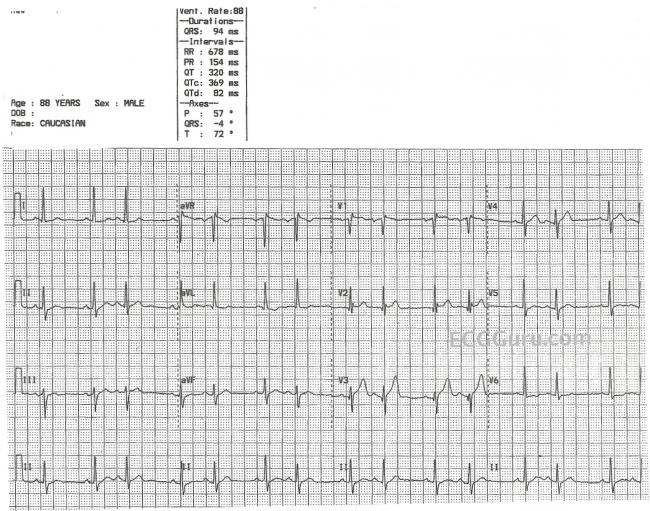
Sinus Rhythm With Atrial Bigeminy Ecg Guru Instructor Resources
What does sinus rhythm with pvc mean
What does sinus rhythm with pvc mean-A ventricular couplet and then 4 beat run of VTachThe pause surrounding the PVC is equal to double the preceding RR interval (= a full compensatory pause)




Pvcs Heart Squad
Mar , 21 · Ventricular Escape Rhythm or Idioventricular Rhythm Ventricular escape rhythm or idioventricular rhythm occurs in the absence of supraventricular stimuli or with bradycardias with heart rate below 40 bpm (sick sinus syndrome or complete AV block distal to the bundle of His) 3Ventricular escape rhythm is observed on the electrocardiogram as a slow, regular rhythmFeb 02, 21 · PVCs can occur in isolation or in repeated patterns Two consecutive PVCs are termed doublets while three consecutive PVCs are named triplets It is important to note that three or more consecutive PVCs are classified as ventricular tachycardia If the PVCs continuously alternate with a regular sinus beat, the patient is in bigeminyMay 19, 16 · Sinus rhythm with a couplet of PVCs 04 a Sinus rhythm with trigeminal PVCs 05 c NSR with a triplet of PVCs 06 a Sinus rhythm with a PVC compensatory pause 07 b Sinus rhythm with quadrigeminal PVCs 08 b Sinus bradycardia with bigeminal PVCs 09 a Sinus rhythm with multifocal PVCs
Apr 01, · There is some evidence from studies looking at these populations that PVC's may lead to heart failure and potentially fatal and nonfatal arrhythmias such as inappropriate sinus tachycardia 39 Related Question Answers FoundAug 01, · Sinus rhythm with PVCs of two different morphologies (arrows) Note the appropriately discordant ST segments / T waves;The rhythm strip shows an underlying sinus rhythm that is undisturbed by the extra events occurring in the ventricles (P waves timing is represented by the pink dots, QRS timing by the blue dots) Notice that the pauses are fully compensatory The P waves show through and fuse with the morphology of the PVCs at the start of the complexes
*PVCs are common arrhythmias, not necessarily associated with heart disease They can occur singly or in 5 different variations;Jun 01, 21 · The Normal Heart Rhythm The normal heart rhythm is controlled by a tiny structure called the sinus node, which is located near the top of the heart's right atrium The sinus node generates the electrical signal that initiates the heartbeat and controls the heart rateMar , 21 · Premature Ventricular Complex PVC marked by the arrow on an EKG in sinus rhythm The compensatory pause is marked in blue The ectopic impulses on the electrocardiogram are premature in relation to the expected impulse of the basic rhythm The QRS complex is abnormal in duration and morphology




Pvcs Heart Squad




Premature Ventricular Complex Pvc Litfl Ecg Library Diagnosis
May 09, 13 · Nice, clear example of ventricular bigeminy with an underlying sinus rhythm We do not know from this strip if the sinus rhythm is a bradycardia at a rate of about 42 per minute, or if the underlying sinus rhythm is actually at a rate of 85 per minute, with every other sinus beat inhibited by the occurance of a PVCRhythm analysis indicates normal sinus rhythm (NSR) at 68 bpm Premature atrial complexes (PACs), Premature junctional complexes (PJCs), and Premature ventricular contractions (PVCs) are present This encounter shows a normal sinus rhythm with a large amount of ectopy This causes an irregular looking rhythm that can easily confuse beginnerRhythm analysis indicates sinus tachycardia at over 100 bpm First degree heart block is also present This encounter shows a fast rate over 100 bpm, with a regular rhythm and P waves, indicating sinus tachycardia The extremely long delay between the P wave and QRS indicates first degree heart block




Premature Ventricular Contraction Article




Benign Pvcs A Heart Rhythm Doctor S Approach
Jun 03, 13 · PVCs are probably the second most common rhythm problem I see Atrial arrhythmia, including AF and atrial flutter are the most common This image shows PVCs (beats 2, 4, 6 etc) occurring in what we call a bigeminal pattern Atrial or ventricular beats that appear in an every other beat pattern are referred to as bigeminy DrMany of the ECG rhythm strips come from the collection of the late Dr Alan Lindsay, master teacher of electrocardiography Most of the 12 and 6lead ECGs were recorded at LDS Hospital in Salt Lake City, Utah Marquette Electronics has also given permission to use ECG rhythms and diagrams from their educational postersAug 15, · The ECG criteria to diagnose premature ventricular contractions (PVCs) is discussed with 12lead ECG examples including ventricular bigeminy




Pin On Ekg




Ecg Learning Center An Introduction To Clinical Electrocardiography
Your heart's normal, or sinus, rhythm is controlled by a natural pacemaker, the sinus node, which creates electrical impulses that travel across the atria to the ventricles, causing them to contract and pump blood out to your lungs and body in what is known as normal sinus rhythm PVCs occur when ventricle contractions beat sooner than theTrigeminy is irregular heart beat or arrhythmia comprising of a repetitive series of 2 normal heart beats and 1 premature beat With regards to ECG activity readings, trigeminy refers to a rhythm wherein every third heart beat is ectopic, ie starting from some other area and not the sinus nodeJun 04, 21 · Electrocardiographic Features PJCs have the following features Narrow QRS complex, either (1) without a preceding P wave or (2) with a retrograde P wave which may appear before, during, or after the QRS complex If before, there is a short PR interval of < 1 ms and the "retrograde" P waves are usually inverted in leads II, III and aVF Occurs sooner than would be




Premature Ventricular Contraction An Overview Sciencedirect Topics



1
Sinus Rhythm with PVCs for an ECG machine This video is provided by Cascade Healthcare Services, A leading provider of healthcare training courses includingDec 24, 19 · Premature atrial contractions are very common in normal individuals and increase with aging They can cause palpitations and an irregular pulse but are benign in and of themselves Frequent PACs (more than 1% of total heart beats) are a marker of increased risk of atrial fibrillation, stroke, and deathNormal Sinus Rhythm PVC (couplets) Torsades Des Pointes Idioventricular Rhythm Fine Ventricular Fibrillation Sinus Tachycardia Premature Ventricular Complex Atrial Fibrillation Quadrigeminy PVC Run of VTACH Trigeminy PVC Atrial Flutter




Ecg Interpretation Of Arrhythmias Tusom Pharmwiki



Carolinas Ekg Blog Cmc Compendium
Dec 02, 15 · Ventricular arrhythmias included premature ventricular complexes (PVCs) in 434%, >0 PVCs per 24 hours in 33%, multifocal PVCs in 53%, nonsustained ventricular tachycardia in 07%, and accelerated idioventricular rhythm in 03% Bradyarrhythmias included sinus pause >3 seconds in 03%, and seconddegree AV block in 24%Sinus rhythm with very occasional isolated supra ventricular ectopic beats and ventricular ectopic beats with one ventricular couplet Occasional TWave inversion in some areas No pauses or AV block Max heart rate 150bpm1) Bigeminy every sinus beat followed a PVC 2) Trigeminy 2 sinus beats are followed by a PVC




Are Your Palpitations Due To Benign Premature Ventricular Contractions Pvcs The Skeptical Cardiologist




Matters Of The Heart Pvcs Patmac Rn
Additional Abnormal Heart Rhythms Atrial Atrioventricular Junctional Sinus Normal Sinus Rhythm Sinus Arrhythmia Sinus Bradycardia ST Segment Abnormalities Ventricular ECM/ECG Rat Library Normal Sinus Rhythm Sinus Arrhythmia Sinus Bradycardia ST Segment Abnormalities Ventricular ECM/ECG Rat Library People Publication MediaFigure 3 Premature ventricular contractions in bigeminy Two consecutive premature ventricular contractions are referred to as a pair or couplet If 3 to 30 premature ventricular contractions occur consecutively, it is referred to as nonsustained ventricular tachycardia (if the rate is >100 beats/min) or ventricular rhythm (if the rate isQ An ECG rhythm strip shows a ventricular rate of 128, a regular rhythm, a PR interval of 016 second, a QRS duration of 008, and one upright P wave before each QRS




Bigeminy Wikipedia
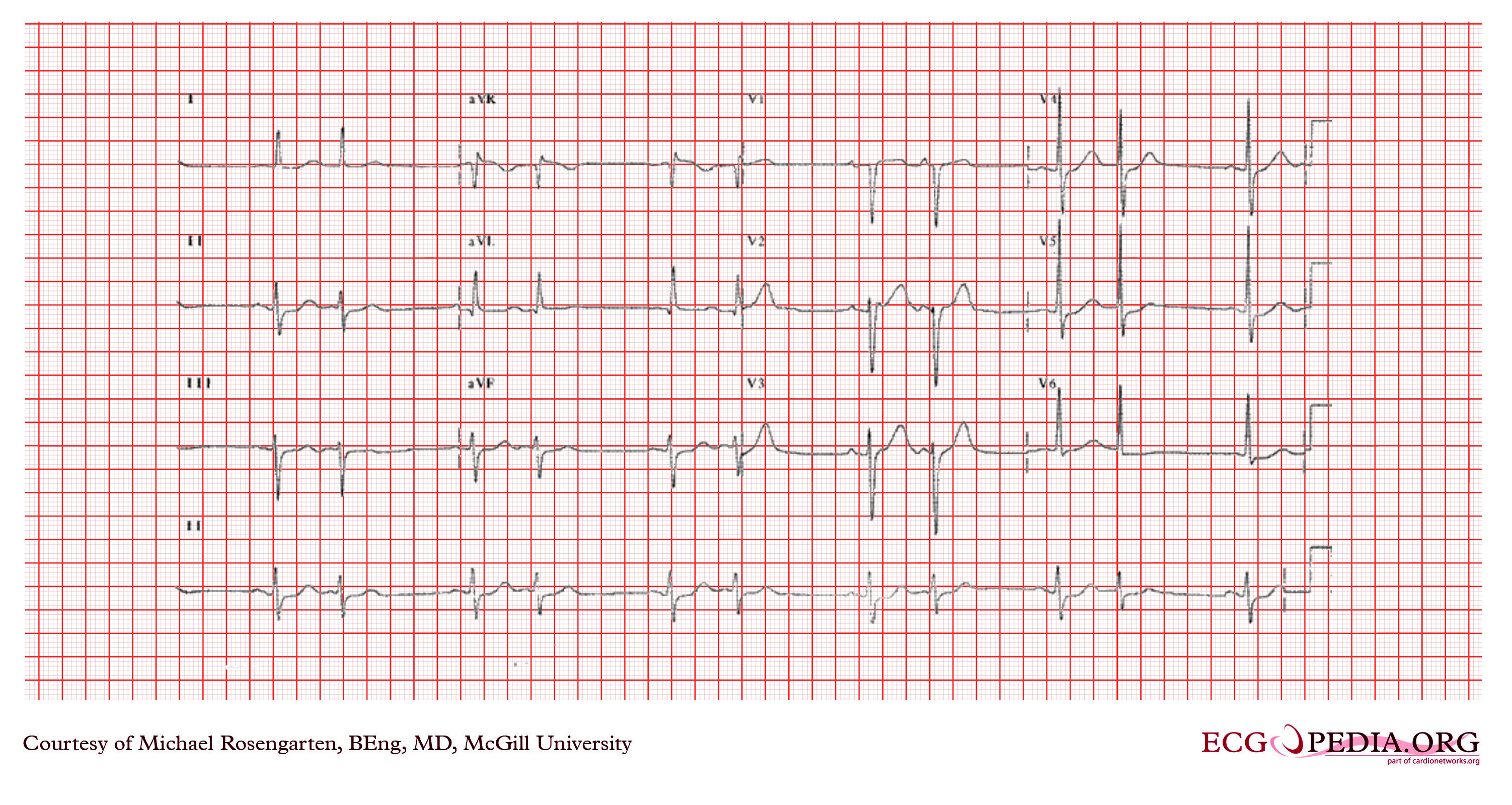



Bigeminal Rhythm Wikidoc
Rhythm Regular with ectopic beats P waves One present before each QRS except when ectopic beats occur PR interval QRS width 08 Interpretation Normal sinus rhythm with PVC's;Oct 19, 16 · The sinus node creates electrical impulses that travel across the atria to the ventricles, causing them to contract and pump blood out to your lungs and body in what is known as normal sinus rhythm In the case of PVCs, the heart doesn't actually skip a beat Instead, an extra beat comes sooner than normalIt would be measurable depending on the underlying rhythm In step 5 we need to look at the QRS complex, so during the PVC it is 4 boxes or 016 seconds, it is about 2 boxes on the others or 008 seconds It is normal for the most part but during the PVC it is wider So in step 6 we identify the rhythm and we have sinus bradycardia with PVCs




Ekg Interpretation




Sinus Rhythm With Atrial Bigeminy Ecg Guru Instructor Resources
Premature atrial contractions (PACs), also known as atrial premature complexes (APC) or atrial premature beats (APB), are a common cardiac dysrhythmia characterized by premature heartbeats originating in the atriaWhile the sinoatrial node typically regulates the heartbeat during normal sinus rhythm, PACs occur when another region of the atria depolarizes before the sinoatrialUnifocal couplet PVCs PVCs Occurring in a Run PVCs Occurring as a Couplet (Pair) Ventricular tachycardia (Vtach) Ventricular fibrillation (Vfib) Normal sinus rhythm with multifocal PVCs Click card to see definition 👆Rhythm Strip Flash Card Practice 1 Sinus Brady Arrhythmia The rate is slow and the rhythm is irregular 2 Sinus Brady heart rate is less than 60 3 Normal Sinus Rhythm 4 Normal Sinus Rhythm 5 Supraventricular Tachycardia (SVT) Narrow complex tachycardia 6 Sinus Tachycardia heart rate greater than 100 7 Normal Sinus Rhythm



Lesson V Cont Ventricular Arrhythmias
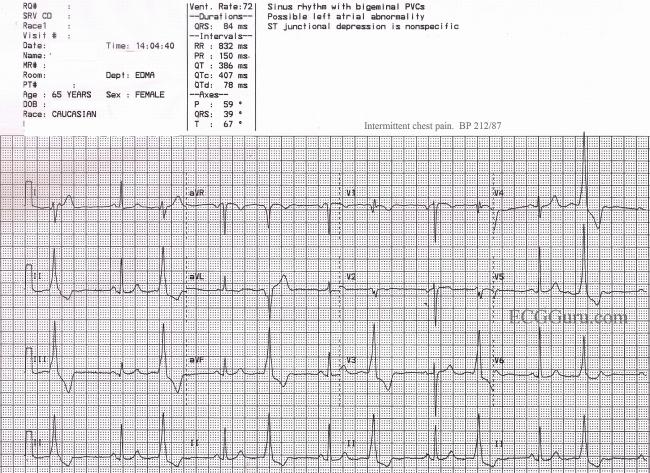



Ventricular Bigeminy Ecg Guru Instructor Resources
Jan 02, 18 · Normal sinus rhythm Normal sinus rhythm is defined as the rhythm of a healthy heart It means the electrical impulse from your sinus node is being properly transmitted In adults, normal sinus1 Additional Examples of Atrial Couplets (6) 2 Aberrated Atrial Couplets Figure 3 Record 1 2 3 Figure 4 Record 213 2 3 3 Aberrated Atrial Couplets with Right and Left Bundle Branch Blocks Figure 4 Record 213 2 3Premature ventricular complexes, or PVCs, are a common clinical problem While patients may be asymptomatic, typically these PVCs cause sensations of skipping, heart pounding, and possibly chest pain, shortness of breath or dizziness



Onlinelibrary Wiley Com Doi Pdf 10 1002 Clc




Monitoring Single Lead Ekg Strip 1 Baseline Rhythm Permanent Download Scientific Diagram
Pediatric Arrhythmias and EKGs for the Health Care Provider teaches readers in a quick, ataglance approach To obtain an interpretable pediatric tracing To implement a proper measurement method To understand both normal and abnormal EKGs To learn the quickest and most accurate QTc method To follow an organized format for rhythm analysisPremature beats that start in your heart's upper chambers are premature atrial contractions, or PACs Those that start in the lower chambers are premature ventricular contractions, or PVCs Watch an animation of a normal heartbeat Testing and treatment Infrequently, premature contractions can be caused by disease or injury to the heartV Tach may occur in paroxysms of three or more PVC's separated by the underlying rhythm (nonsustained V Tach or Paroxysmal Ventricular Tachycardia), or persist for a long period of time (sustained ventricular tachycardia) The rhythm is usually regular, but it may be slightly irregular




Premature Ventricular Cardio Cardiovascular World Facebook




Ventricular Bigeminy Ecg Example 1 Learntheheart Com
Aug 06, 16 · Sinus rhythm with a triplet and couplet of PVCs Sinus rhythm with a triplet and couplet of PVCs Posted by Unknown at 0300 Email ThisBlogThis!Share to TwitterShare to FacebookShare to Labels Couplet , TripletSinus bradycardia, couplets, and ventricular tachycardia were detected mor ane ofted sinuns tachycardias, sinus arrhythmia an asystold ,e less ofte in n patients with a history of cardiac disease than in those without such a history (Figure 1) However, the differences were not significant Sinus tachycardias, sinus bradycardias, and frequent




How To Interpret Read Ekgs Like A Boss Master Heart Rhythms Education Nursejanx




Some Ecg Patterns A Normal Sinus Rhythm B Ventricular Tachycardia Download Scientific Diagram




Premature Ventricular Contractions Premature Ventricular Complex Premature Ventricular Beats Ecg Echo




Premature Ventricular Contractions Pvc Boss Rn




Ecg Learning Center An Introduction To Clinical Electrocardiography




Ecg Review Bigeminal Term Misuse 03 12 01 Ahc Media Continuing Medical Education Publishing




Prague Icu




Pvcs Heart Squad




Premature Ventricular Complex Pvc Litfl Ecg Library Diagnosis



Premature Ventricular Contractions Pvc Boss Rn
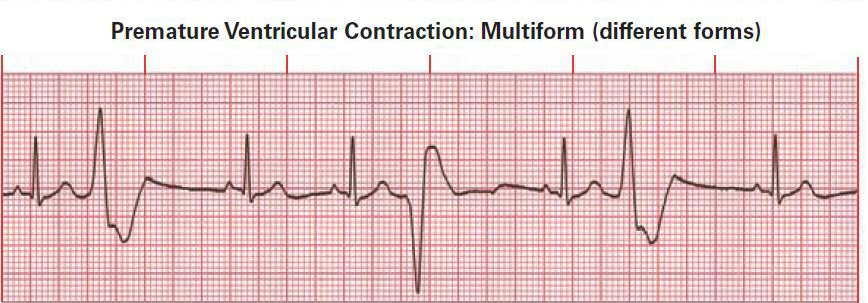



Premature Ventricular Contractions Pvc Boss Rn




Pvc Ecg Example 2 Learntheheart Com



1




Telemetry Technician Course Ekg Test Review




Ekg Medic Rhythms Atrial And Vent Flashcards Quizlet
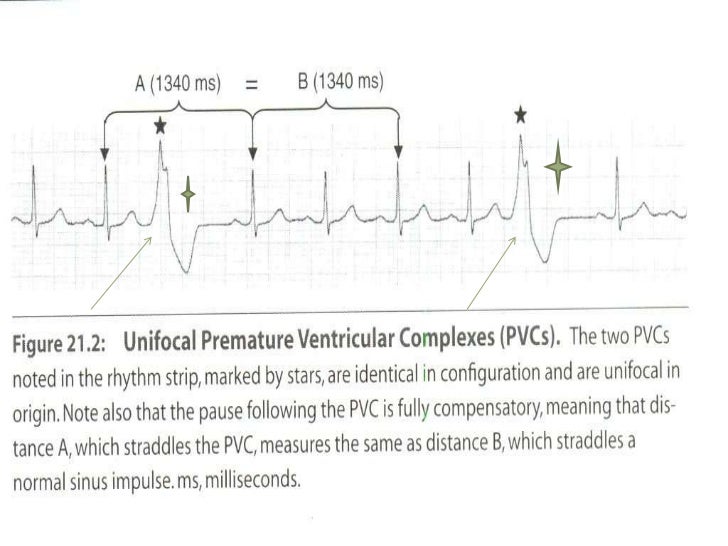



Vpcs



Q Tbn And9gcqzbueda1zajkicsv1otpd2o7fsh7zktpoxhbvmyph0nfg Vqf1 Usqp Cau
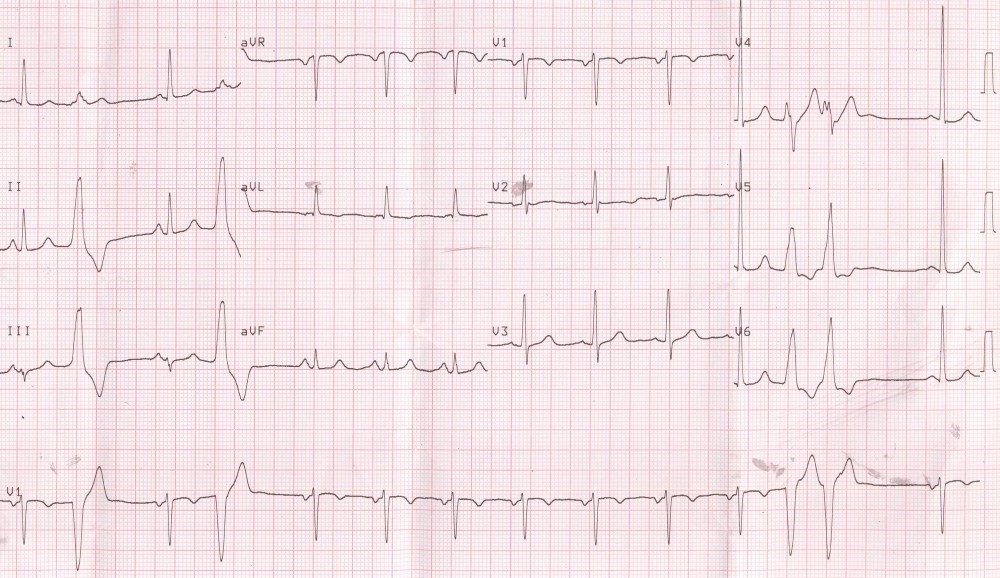



Ventricular Arrhythmia All About Cardiovascular System And Disorders




Ectopic Beats Palpitations The Student Physiologist




Cardiac Arrhythmias Prezentaciya Onlajn




Acls Rhythm Test 2 A 74 Year Old Woman With Chest Pain Blood Pressure 192 90 And Rates Her Pain 9 10 Pdf Free Download




Bigeminy Wikiwand
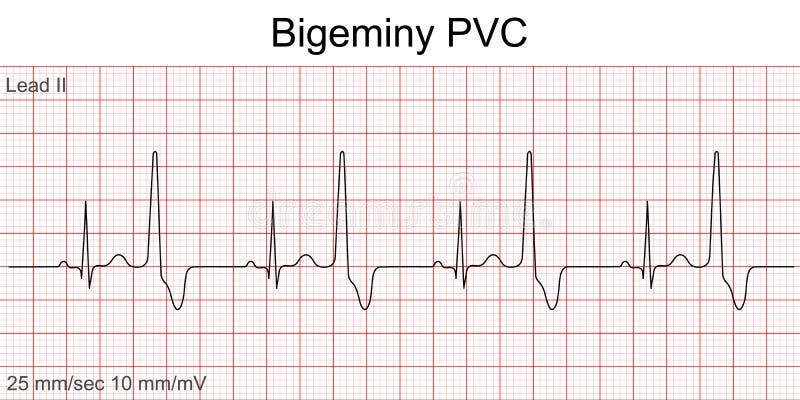



Ventricular Fibrillation Heart Stock Illustrations 69 Ventricular Fibrillation Heart Stock Illustrations Vectors Clipart Dreamstime



1




Twelve Lead Ecg Showing Ventricular Bigeminy Doublet Pvc S With An Download Scientific Diagram
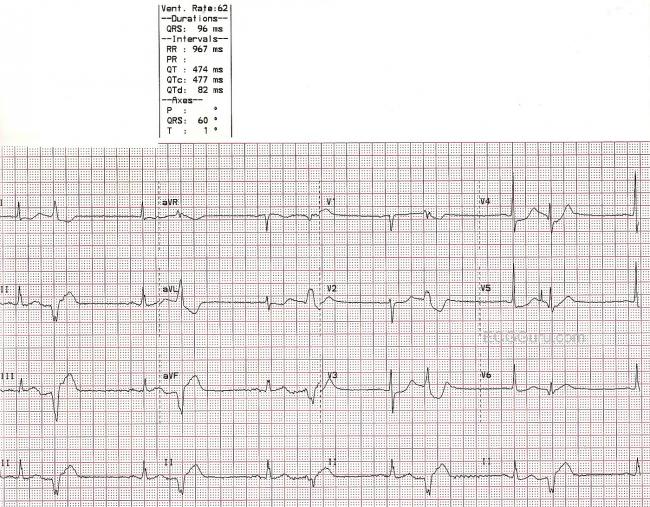



Ventricular Bigeminy Ecg Guru Instructor Resources




Prague Icu




1 11 Ventricular Arrhythmias B Pvc S Cardiac Rhythm Interpretation




Ecg Educator Blog Ventricular Couplets



Http Www Smj Org Sg Sites Default Files 5210 5210es1 Pdf




Premature Ventricular Complex Pvc Litfl Ecg Library Diagnosis




Alivecor Kardia Has A Premature Beat Problem How Pvcs And Pacs Confuse The Mobile Ecg Device The Skeptical Cardiologist
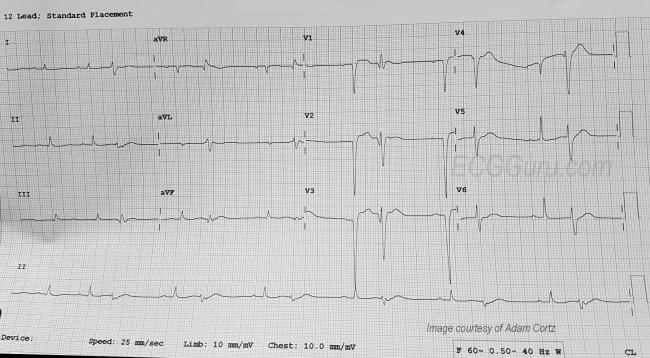



Ventricular Bigeminy Ecg Guru Instructor Resources




Course Description Rev 2 0 7 13 Page 1 Of 26 Pdf Free Download




Premature Atrial Contractions Are They Benign Or Malignant The Skeptical Cardiologist




Premature Ventricular Contractions Pvcs Ecg Review Criteria And Examples Learntheheart Com




Evaluation And Management Of Ventricular Premature Beats Consultant360
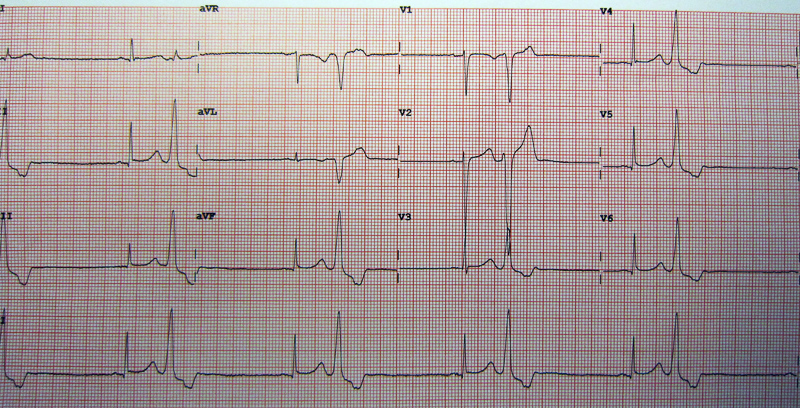



Bigeminy Definition And Synonyms Of Bigeminy In The English Dictionary




Premature Ventricular Complex Pvc Litfl Ecg Library Diagnosis
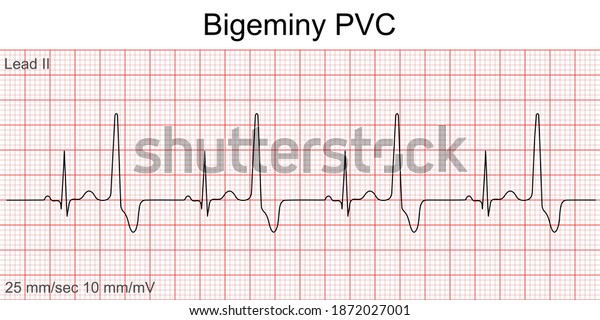



Electrocardiogram Show Bigeminy Pvc Pattern Heart Stock Vector Royalty Free




Electrophysiology Of The Heart Ecg Monitoring The Ecg



Rhythm Strip Flash Card Practice




Practical Electrocardiography Rate And Rhythm Scott E Ewing



Mark Hammerschmidt Arrythmia Faq




Rate And Rhythm Premature Ventricular Contraction Pvc Youtube




Premature Ventricular Complexes Medictests




Concealed Conduction Of Premature Ventricular Complexes Resulting In Av Nodal Block Sciencedirect




Premature Ventricular Contraction An Overview Sciencedirect Topics




Ectopic Complexes And Rhythms Thoracic Key




Bigeminal Rhythm Wikidoc




Kamlya Balgoon 09 Av Blocks Av Block Occur When The Conduction Of Impulse Through Av Node Decrease Or Stop Prolonged P R Interval Or More P Waves Ppt Download




Premature Ventricular Complex Pvc Litfl Ecg Library Diagnosis
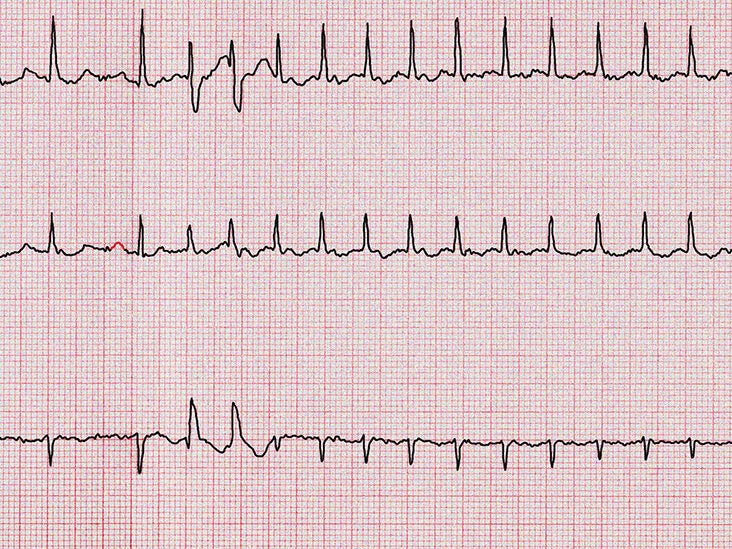



Bigeminy Causes Symptoms And Treatments




Anaesthesia Uk Ventricular Arrhythmias




What Is The Purpose Of Ventricular Couplets Quora




Ecg Rhythms Escape Capture Bigeminy



Www Heartlungcirc Org Article S1443 9506 3 Pdf




Ecg Learning Center An Introduction To Clinical Electrocardiography




Ekg Patterns Premature Atrial Ventricular Contractions Pacs Pvcs Youtube




How To Calculate Heart Rate From Ecg Arxiusarquitectura




Only Use The Options Provided Answers May Be Used Chegg Com




Premature Ventricular Contractions Pvc Boss Rn




Bigeminy Wikipedia
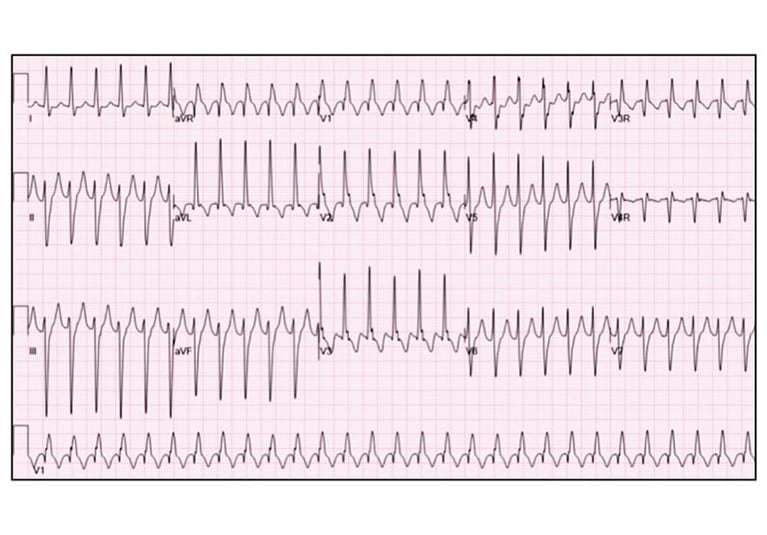



Pediatric Ventricular Arrhythmia In A Normal Heart Mayo Clinic




Bigeminy Wikipedia
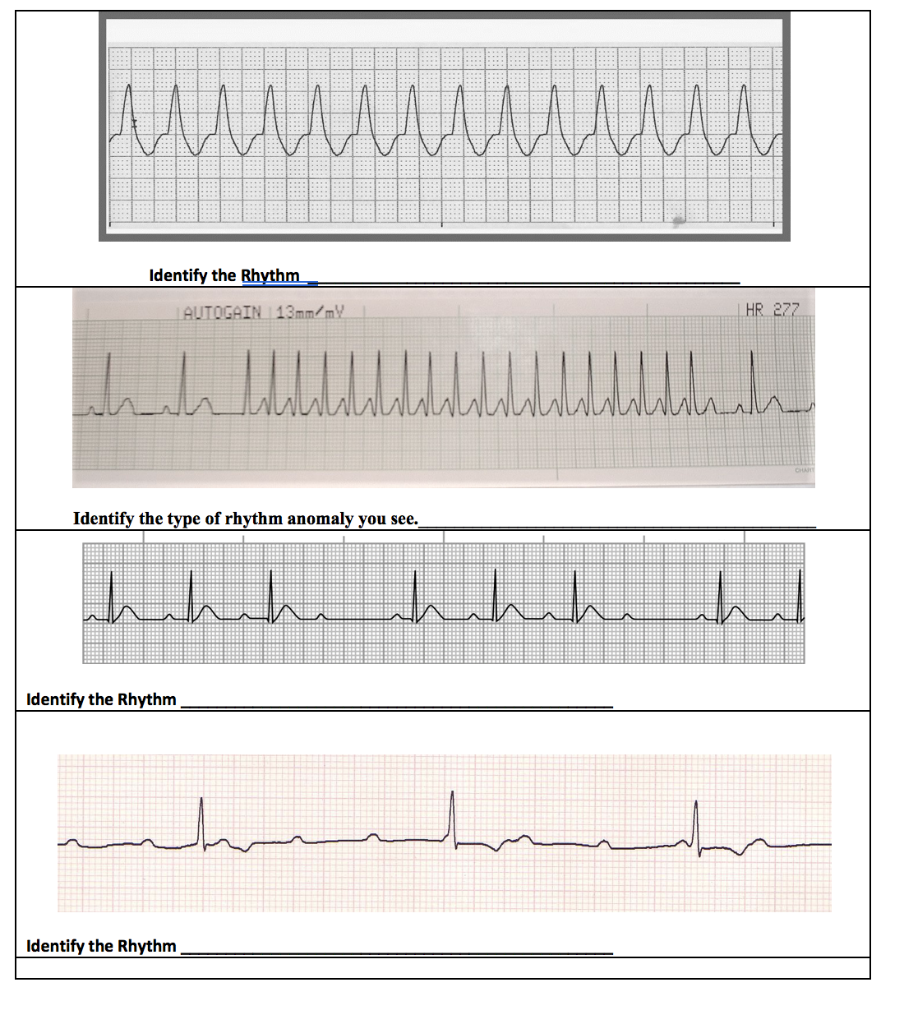



Only Use The Options Provided Answers May Be Used Chegg Com




Ecg Educator Blog Ventricular Bigeminy



Rhythm Strip Flash Card Practice




Premature Ventricular Contractions Treatment Cape Town




Ventricular Bigeminy Ecg Guru Instructor Resources




Anaesthesia Uk Ventricular Arrhythmias




Ekg Medic Rhythms Atrial And Vent Flashcards Quizlet




Premature Ventricular Cardio Cardiovascular World Facebook




Baseline Electrocardiogram Ekg Sinus Rhythm With Monomorphic Pvc Download Scientific Diagram




Pin On Ekg




Evaluation And Management Of Ventricular Premature Beats Consultant360




Clinical Relevance Of Arrhythmias During Sleep Guidance For Clinicians Heart




Premature Atrial Contractions Causes Symptoms Diagnosis Treatment
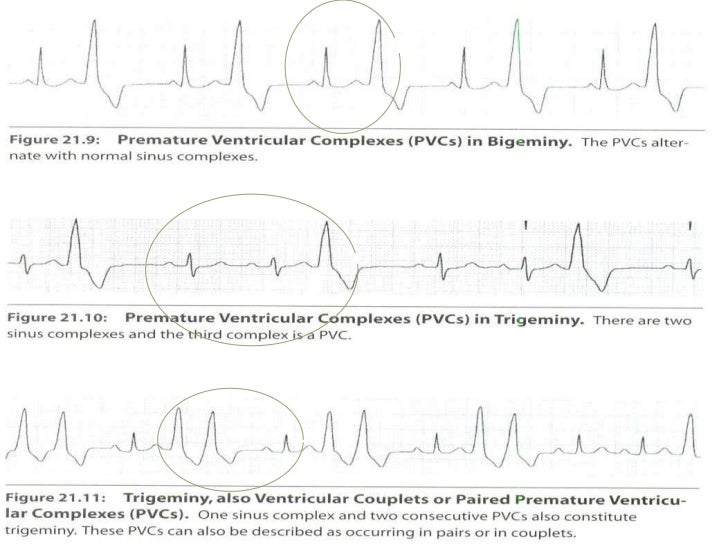



Vpcs
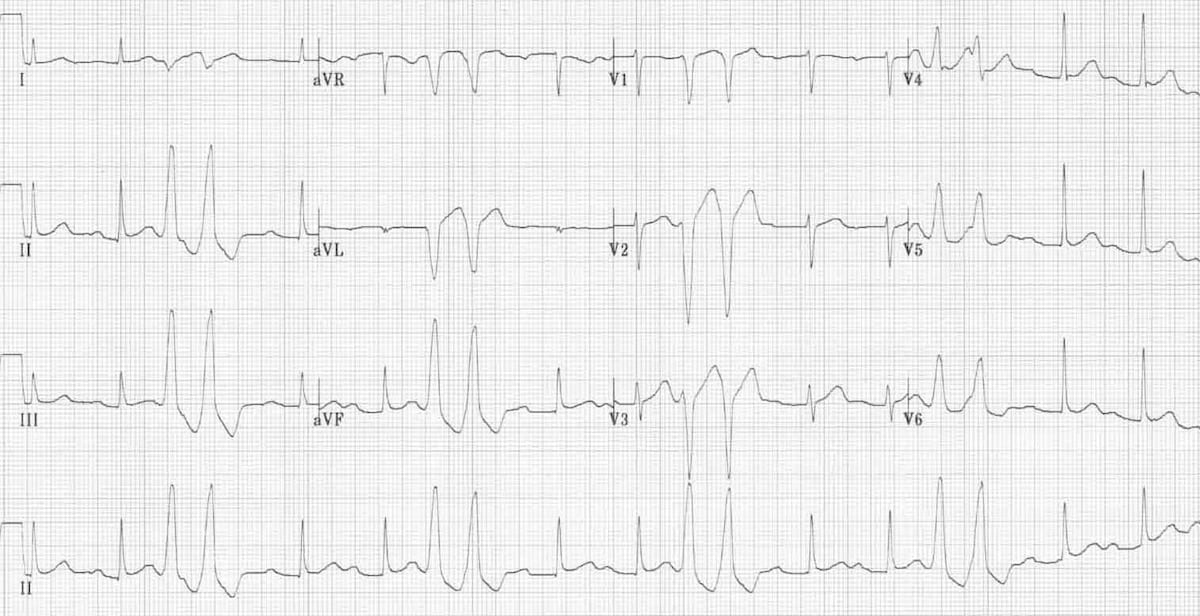



Premature Ventricular Complex Pvc Litfl Ecg Library Diagnosis



Onlinelibrary Wiley Com Doi Pdf 10 1002 Clc



Why Are Premature Ventricular Contractions Common In Healthy Persons Quora


コメント
コメントを投稿